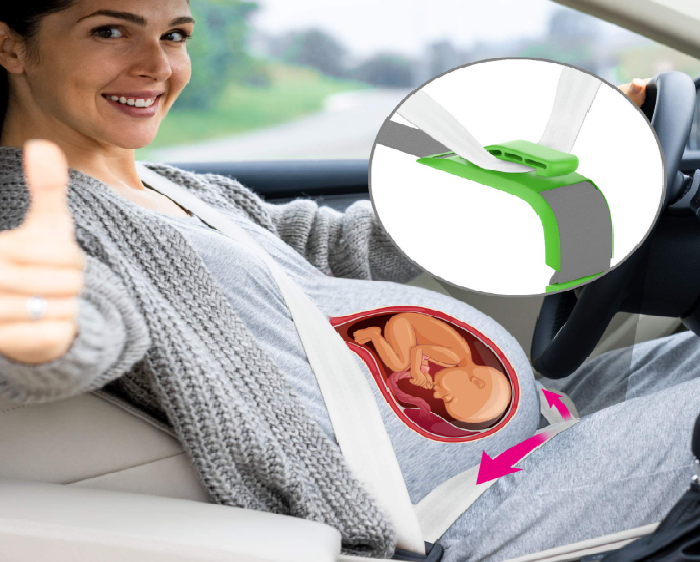Tips to Fasten Seat Belt during Pregnancy of Female Drivers
- On Jan, 17, 2023
- Admin
No one is aware of the extent of the suffering that a pregnant woman is exposed to in the exercise of her daily activities. For example, driving a car to go to work, to the market, or any other place is one of the most important tasks that a pregnant woman must take into account during pregnancy, as making any wrong movement would put mother and fetus at risk. No specific research study has been conducted on this topic in Malaysia and no data are available, which can put light on this matter. Malaysian Institute of Road Safety Research’s (MIROS) review report “Review on Safety of Pregnant Occupant Travelling With or Without Restraint in a Passenger Vehicle” dated 2009 mainly relies on international data, particularly American research data, in which most of resources are covered from 1970 to 2008.

A study conducted by Lam et al. (2016) titled “Seatbelt use by pregnant women: A survey of knowledge and practice in Hong Kong” (Hong Kong Med J, 22:420–7) surveyed the current practice and knowledge of pregnant women in Hong Kong about seat belt use, and identified determining factors. A cross-sectional survey using a convenient sampling was carried out from January to April 2015. Self-administered questionnaires were distributed to postpartum women in the postnatal ward of United Christian Hospital (UCH) in Hong Kong. There were 769 postpartum women in the postnatal ward during the study period. Total 550 questionnaires were distributed by convenience and the response rate was 91% with 501 questionnaires returned. The remaining women (n=49, 9%) either refused to participate or did not return the questionnaire. At the end of the recruitment period, 495 (90%) questionnaires were valid for analysis.
Among the main findings of the study, 76.6% of Hong Kong pregnant women were consistent seat belt wearers before pregnancy. Compliance was reduced during all trimesters, and decreased as gestation progressed. Only 26 women changed their behavior from non-users to users after becoming pregnant. It also demonstrated the misconception about the effects of seat belt use on pregnancy and the fetus. Pregnant women’s knowledge about seat belt use was inadequate and only a minority had received relevant information. Women who held a driving license or had a higher education level were more likely to wear a seat belt before and during pregnancy. Women with a tertiary education or above were more knowledgeable about seat belt use.Reasons for not using a Seat Belt during Pregnancy
With regard to the reasons for not using a seat belt at any time during pregnancy, 156 (89.1%) of 175 women stated that the seat belt caused discomfort, 22 (12.6%) thought that seat belts were not useful, and 79 (45.1%) worried that they would cause harm to the fetus.
Information on Fastening Seat Belt during Pregnancy
Only 32 (6.5%) women had received information about seat belt use. Among them, 13 (40.6%) had derived the information from the internet, others from staff of a government and private clinic, magazine, and publications of Transport Department.
This study demonstrated decreased compliance with seat belt use during pregnancy that continued to decrease as pregnancy progressed. It is well known that prevention plays a major role in ensuring maternal and fetal survival in road traffic accidents. Motor vehicle crashes are responsible for severe maternal injury and fetal loss. Despite existing knowledge about the protective effects of wearing a seat belt, pregnant women remain poorly compliant.
Therefore, future studies should assess the knowledge of Malaysian Ministry of Health Care workers about use of seat belts in pregnancy may enhance the awareness and involvement of medical professionals in educating pregnant women on this issue. Publicity and education about road safety by health care providers and the government are advised, and targeting the lower compliant groups may be more effective and successful.
Among other precautionary guidelines, we offer a set of driving tips for pregnant women that could help them take all preventive steps in terms of public safety, sitting position while driving, and many other tips for pregnant women while driving, which are included in the list of safe driving tips.
Tips for Pregnant Women while Driving
Many women fall into a spiral of thinking when they want to drive a car during pregnancy, so the following questions abound: Do car seat belts cause any harm or health risks to pregnant women? Is there a danger of a pregnant woman driving her car? In what month of pregnancy can you drive a car? In addition, more and more concerns that pregnant woman may have about driving in a car during the months of pregnancy. Well, the matter is not as dangerous as you imagine, but in order to ensure the safety of a pregnant woman while driving, care must be taken in order to preserve your health and the health of your child, and a set of tips for pregnant women in the car must be followed to achieve traffic safety.
1. Take a Correct Sitting Position
First, driving for a pregnant woman is different from the normal position, as we advise the pregnant woman to pay great attention to her sitting position behind the wheel, and you should adjust the position of the seat so that you feel comfortable while driving. To make sure the safety of a pregnant woman while driving a car, a distance of at least 25 centimeters must be left between her body and the steering wheel. So that no contact occurs between her body and the steering wheel. Moreover, to avoid exposure to any direct physical harm in the event of an accident and to enter into a whirlwind of dealing with a traffic accident.
The position of the driver’s seat must be adjusted with the passage of the months of pregnancy, while making sure that it is comfortable and safe. This and the correct position of the driving seat during the first trimester of pregnancy differs from months 4 to 9, so be sure to adjust the position of the seat over the months of pregnancy and maintain an upright position by adjusting the correct sitting position.
2. Fasten Your Seat Belt Properly
We continue talking about important tips for driving a car during pregnancy, and we discuss the seat belt now, which is of great importance in driving vehicles, as it reduces exposure to serious injuries in the event of traffic accidents, and how if a pregnant woman wore it while driving? However, you must have heard from your close friends during their pregnancy the extent of the suffering they were subjected to when tying the seat belt properly, due to the size of the pregnant woman’s belly. Woman should always make sure to wear the seat belt in the car properly, how? You must fasten the horizontal part of the seat belt below the belly so that it stabilizes the woman’s body at the pelvic area and avoids pressure on the fetus, and the diagonal shoulder belt must pass over the abdomen to the middle of the chest.
Fastening a seat belt for a pregnant woman while driving reduces the risk of serious physical injury to the fetus and the mother if it is worn properly, thus avoiding any serious injuries such as rupture of the placenta or uterus.
3. Activate the Vehicle’s Airbag
A pregnant woman while driving a car must activate the airbag, especially in the front seat, while driving or sitting in the front passenger seat in the car. Pregnant women believe that airbags will put pressure on the abdomen and thus negatively affect the fetus, but on the contrary, airbags help reduce the risk of traffic accidents for pregnant women by up to 50%, and this is one of the most important tips for pregnant women while driving that they must adhere to.
4. Avoid Driving Long Distances
It is preferable for a pregnant woman to avoid driving a car for long hours or traveling long distances. In the event that she is forced to take long trips, it is preferable to stop several times during the trip, and take a short walk to stimulate blood circulation in the extremities of her body, or eat some snacks or go to washroom or other possible activates. Here we emphasize the need for a pregnant woman to know the appropriate time to stop driving during pregnancy. In addition, the matter is relative, as there is no real danger from continuing to drive for long hours in the case of a healthy pregnancy, until the last months of pregnancy, and doctors advise pregnant women to stop driving a car if it feels tired or uncomfortable while driving.
5. Wear Loose and Comfortable Outfit
Not just while driving, but throughout your pregnancy! Doctors stress the need for pregnant women to wear comfortable, loose clothes and flat shoes while driving to give them more comfort, and to avoid wearing tight clothes. When a pregnant woman drives a car, tight clothes rub against the skin and impede blood circulation, which may lead to dangers to the fetus. Loose clothes allow a pregnant woman a good space for movement, and better control of the accelerator and brakes if necessary.
6. Make Sure to Have Healthy Meals on Time
A few raw nuts, fruits, vegetables, and a bottle of water is all that a pregnant woman needs while driving a car to provide her body and her fetus with energy, especially, when a pregnant woman drives a car in the summer to avoid dehydration.
7. Be Prepared for Emergencies
Finally, among the list of tips for a pregnant woman while driving, she should always prepare herself for the worst. A pregnant woman while driving may be exposed to many emergencies such as vomiting or lower back pain, so care must be taken to put vomiting bags and some comfortable pillows to improve the sitting position and relieve pain.
May God keep you and your baby safe, and always make sure to follow the above mentioned advices while driving to have a safe and comfortable driving experience. Don’t forget to leave a comment about your driving experiences during pregnancy.
If you are interested to learn important rules about overtaking, please read the following article:
About the Author
Dr. Hafiz Abbas holds a PhD in Usuluddin from Universiti Sultan Azlan Shah (USAS), Malaysia. He is well versed with Islamic theology, Seerat-un-Nabi (SAW), and principles of Hadith. In addition, he is a teacher of Arabic.
Edited by: Ch. Mahmood Anwar
Do comment on this article if you liked our post!





















